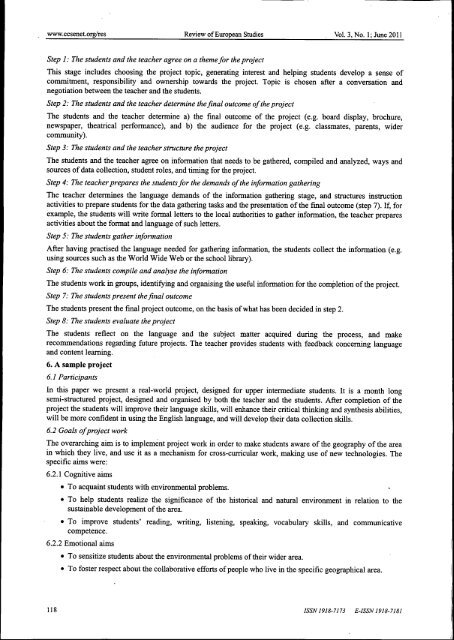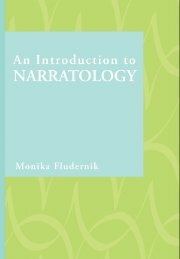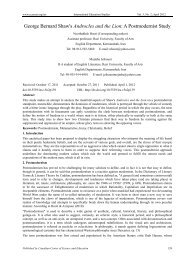Literature Review Sample #2 - ELSRU
Literature Review Sample #2 - ELSRU
Literature Review Sample #2 - ELSRU
Create successful ePaper yourself
Turn your PDF publications into a flip-book with our unique Google optimized e-Paper software.
www.ccsenet.org/res <strong>Review</strong> of European Studies Vol. 3, No. 1; June 2011<br />
Step 1: The students and the teacher agree on a theme for the project<br />
This stage includes choosing the project topic, generating interest and helping students develop a sense of<br />
commitment, responsibility and ownership towards the project. Topic is chosen after a conversation and<br />
negotiation between the teacher and the students.<br />
Step 2: The students and the teacher determine the final outcome of the project<br />
The students and the teacher determine a) the fmal outcome of the project (e.g. board display, brochure,<br />
newspaper, theatrical performance), and b) the audience for the project (e.g. classmates, parents, wider<br />
community).<br />
Step 3: The students and the teacher structure the project<br />
The students and the teacher agree on information that needs to be gathered, compiled and analyzed, ways and<br />
sources of data collection, student roles, and timing for the project.<br />
Step 4: The teacher prepares the students for the demands of the information gathering<br />
The teacher determines the language demands of the information gathering stage, and stmctures instruction<br />
activities to prepare students for the data gathering tasks and the presentation of the fmal outcome (step 7). If, for<br />
example, the students will write formal letters to the local authorities to gather information, the teacher prepares<br />
activities about the format and langtiage of such letters.<br />
Step 5: The students gather information<br />
After having practised the language needed for gathering information, the students collect the information (e.g.<br />
using sotirces such as the World Wide Web or the school library).<br />
Step 6: The students compile and analyse the information<br />
The students work in groups, identifying and organising the useful information for the completion of the project.<br />
Step 7: The students present the final outcome<br />
The students present the final project outcome, on the basis of what has been decided in step 2.<br />
Step 8: The students evaluate the project<br />
The students reflect on the language and the subject matter acquired during the process, and make<br />
recommendations regarding future projects. The teacher provides students with feedback conceming language<br />
and content leaming.<br />
6. A sample project<br />
6.1 Participants<br />
In this paper we present a real-world project, designed for upper intermediate students. It is a month long<br />
semi-stmctured project, designed and organised by both the teacher and the students. After completion of the<br />
project the students will improve their language skills, will enhance their critical thinking and synthesis abilities,<br />
will be more confident in using the English language, and will develop their data collection skills.<br />
6.2 Goals of project work<br />
The overarching aim is to implement project work in order to make students aware of the geography of the area<br />
in which they live, and use it as a mechanism for cross-curricular work, making use of new technologies. The<br />
specific aims were:<br />
6.2.1 Cognitive aims<br />
• To acquaint students with environmental problems.<br />
• To help students realize the significance of the historical and natural environment in relation to the<br />
sustainable development of the area.<br />
• To improve students' reading, writing, listening, speaking, vocabulary skills, and communicative<br />
competence.<br />
6.2.2 Emotional aims<br />
• To sensitize students about the environmental problems of their wider area.<br />
• To foster respect about the collaborative efforts of people who live in the specific geographical area.<br />
118 ISSN 1918-7173 E-ISSN 1918-7181





